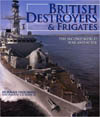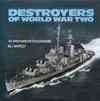| Navy | The Royal Navy |
| Type | Destroyer |
| Class | Havant |
| Pennant | H 32 |
| Built by | J.S. White & Co. (Cowes, U.K.) |
| Ordered | |
| Laid down | 30 Mar 1938 |
| Launched | 17 Jul 1939 |
| Commissioned | 19 Dec 1939 |
| Lost | 1 Jun 1940 |
| Loss position | 51° 08'N, 2° 15'E |
| History | Requisitioned by the Royal Navy on 4 September 1939 while being built for the Brazilian Navy. Named HMS Havant. HMS Havant (Lt.Cdr. Anthony Frank Burnell-Nugent, DSC, RN) was heavily damaged by German aircraft off Dunkirk during the evacutation there. Havant was sunk by the minesweeper HMS Saltash (Lt.Cdr. T.R. Fowke, RN). |
| Former name | Brazilian Javary |
Commands listed for HMS Havant (H 32)
Please note that we're still working on this section
and that we only list Commanding Officers for the duration of the Second World War.
| Commander | From | To | |
| 1 | Lt.Cdr. Anthony Frank Burnell-Nugent, RN | 21 Nov 1939 | 1 Jun 1940 |
You can help improve our commands section
Click here to Submit events/comments/updates for this vessel.
Please use this if you spot mistakes or want to improve this ships page.
Notable events involving Havant include:
16 Mar 1940
HMS Tarpon (Lt.Cdr. H.J. Caldwell, RN) departed the Clyde area for Portsmouth. She was escorted by HMS Havelock (Capt. E.B.K. Stevens, DSC, RN) and HMS Havant (Lt.Cdr. A.F. Burnell-Nugent, RN). (1)
18 Mar 1940
Convoy HX 28.
This convoy departed Halifax on 18 March 1940.
It was made up of the following merchant vessels; Aldersdale (British (tanker), 8402 GRT, built 1937), Annik (Norwegian, 1333 GRT, built 1940), Antigone (British, 4545 GRT, built 1928), Athelknight (British (tanker), 8940 GRT, built 1930), Avelona Star (British, 13376 GRT, built 1927), Beckenham (British, 4636 GRT, built 1937), Bengore Head (British, 2609 GRT, built 1922), Boreas (Norwegian, 2801 GRT, built 1920), Bridgepool (British, 4845 GRT, built 1924), British Captain (British (tanker), 6968 GRT, built 1923), British Prudence (British (tanker), 8620 GRT, built 1939), Cardita (British (tanker), 8237 GRT, built 1931), Collegian (British, 7886 GRT, built 1923), Cordelia (British (tanker), 8190 GRT, built 1932), Dalcroy (British, 4558 GRT, built 1930), Dromore Castle (British, 5242 GRT, built 1919), Edward F. Johnson (British (tanker), 10452 GRT, built 1937), Empire Confidence (British, 5023 GRT, built 1935), Eskdalegate (British, 4250 GRT, built 1930), Europe (Norwegian (tanker), 8371 GRT, built 1934), Grainton (British, 6341 GRT, built 1929), Harlingen (British, 5415 GRT, built 1933), Henri Desprez (French (tanker), 9805 GRT, built 1932), Hopepeak (British, 5179 GRT, built 1938), Indiana (French, 5751 GRT, built 1917), Induna (British, 5086 GRT, built 1925), Inversuir (British, 9456 GRT, built 1938), Jean L.D. (French, 5795 GRT, built 1935), Jumna (British, 6078 GRT, built 1929), Jutland (British, 6153 GRT, built 1928), Lancaster Castle (British, 5172 GRT, built 1937), Lucerna (British (tanker), 6556 GRT, built 1930), Macharda (British, 5998 GRT, built 1938), Malayan Prince (British, 8953 GRT, built 1926), Manchester Citizen (British, 5343 GRT, built 1925), Manchester Port (British, 7071 GRT, built 1935), Matheran (British, 7653 GRT, built 1919), Mathilda (Norwegian, 3650 GRT, built 1920), Narragansett (British (tanker) 10389 GRT, built 1936), Newfoundland (British, 6791 GRT, built 1925), Nicolaou Georgios (Greek, 4108 GRT, built 1930), Politician (British, 7939 GRT, built 1923), Pomella (British (tanker), 6766 GRT, built 1937), Ramsay (British, 4855 GRT, built 1930), Rio Azul (British, 4088 GRT, built 1921), Rockpool (British, 4892 GRT, built 1927), San Demetrio (British (tanker), 8073 GRT, built 1938), San Ernesto (British (tanker), 8078 GRT, built 1939), San Gabriel (British, 4943 GRT, built 1920), Sarthe (British, 5271 GRT, built 1920), Scoresby (British, 3843 GRT, built 1923), Selvistan (British, 5136 GRT, built 1924), Shirak (British (tanker), 6023 GRT, built 1926), Stanwell (British, 5767 GRT, built 1914), Stiklestad (Norwegian (tanker), 9349 GRT, built 1938), Torr Head (British, 5021 GRT, built 1937), Trecarrell (British, 5271 GRT, built 1919), Tuira (Panamanian, 4397 GRT, built 1912), Varanger (Norwegian (tanker), 9305 GRT, built 1925), W.B. Walker (British (tanker), 10468 GRT, built 1935) and Walter D. Munson (Greek, 3703 GRT, built 1917).
On departure from Halifax the convoy was escorted by the battleship HMS Royal Sovereign (Capt. H.B. Jacomb, RN) and the destroyers HMCS Saguenay (Cdr. G.R. Miles, RCN), HMCS Skeena (Lt. H.S. Rayner, RCN) and HMCS Ottawa (Capt. G.C. Jones, RCN).
HMCS Ottawa parted company with the convoy around 1830Q/18.
During the first night out the Lucerna straggled from the convoy due to engine trouble. She managed to rejoin the convoy at 1030 hours on 29 March in position 50°08'N, 15°40'W.
HMCS Saguenay and HMCS Skeena parted company around 1800Q/19.
The convoy then continued on eastwards escorted by HMS Royal Sovereign which parted company with the convoy around 1800O/27 in position 50°22'N, 24°25'W.
Around 0600Z/30, the destroyers HMS Vanessa (Lt.Cdr. E.A. Stocker, RN), HMS Vimy (Lt.Cdr. C.G.W. Donald, RN), HMS Warwick (Lt.Cdr. M.A.G. Child, RN), HMS Antelope (Lt.Cdr. R.T. White, RN) and [most likely] HMS Havant (Lt.Cdr. A.F. Burnell-Nugent, DSC, RN) joined the convoy in approximate position 50°00'N, 12°00'W. [It is possible they did not join all at the same time.]
[According to the Commodore's report the destroyer HMS Havock (Lt.Cdr. R.E. Courage, RN) had also joined this convoy. HMS Havock was however with the Home Fleet and this must have been incorrect. Most likely it was HMS Havant that had joined the convoy as escort, she had been sent out from Plymouth on an A/S hunt on 28 March.]
Later [the Commodore's report does not give a date, time and location] the convoy was split into two sections.
The Irish Sea, west coast section was made up of the following merchant vessels; Aldersdale (arrived at Scapa Flow on 3 April), Annik (arrived at Liverpool on 2 April), Antigone (arrived at Avonmouth on 1 April), Avelona Star (arrived in the Clyde on 2 April), Beckenham (arrived at Liverpool on 2 April), Bengore Head (arrived at Belfast on 2 April), Bridgepool (arrived at Sharpness on 3 April), British Captain (arrived at Liverpool on 2 April), Collegian (arrived at Liverpool on 1(?)/2 April), Dalcroy (arrived in the Clyde on 2 April), Dromore Castle (arrived in the Clyde on 2 April), Eskdalegate (arrived at Liverpool on 1(?)/2 April), Inversuir (arrived at Avonmouth on 2 April), Lancaster Castle (arrived at Liverpool on 1(?)/2 April), Manchester Citizen (arrived at Manchester on 2 April), Manchester Port (arrived at Manchester on 2 April), Newfoundland (arrived at Liverpool on 1(?)/2 April), Politician (arrived at Liverpool on 1(?)/2 April), Ramsay (arrived at Liverpool on 1(?)/2 April), Rio Azul (arrived at Ardrossan on 4(?) April), Rockpool (arrived at Liverpool on 1(?)/2 April), San Demetrio (arrived in the Clyde on 2 April), San Gabriel (arrived at Liverpool on 2 April), Shirak (arrived in the Clyde on 2 April), Stanwell (arrived at Swansea on 2 April), Torr Head (arrived at Dublin on 2 April), Tuira (arrived at Liverpool on 2 April) and Varanger (arrived at Liverpool on 1(?)/2 April). They were escorted by HMS Vimy and HMS Warwick which both arrived at Liverpool on 2 April.
The Channel / east coast section was made up of the following merchant vessels; Athelknight (arrived at Plymouth on 1 April), Boreas (arrived in the Downs on 2 April), British Prudence (arrived at Weymouth on 1 April), Cardita (arrived at Le Havre on 2 April), Cordelia (arrived at Southampton on 2 April), Edward F. Johnson (arrived in the Downs on 2 April), Empire Confidence (arrived in the Downs on 2 April), Europe (arrived at Bordeaux on 2 April), Grainton (arrived in the Downs on 2 April), Harlingen (arrived in the Downs on 2 April), Henri Desprez (arrived at Le Havre on 2 April), Hopepeak (arrived in the Downs on 2 April), Indiana (arrived at Le Havre on 2 April), Induna (arrived in the Downs on 2 April), Jean L.D. (arrived at La Pallice on 1 April), Jumna (arrived in the Downs on 2 April), Jutland (arrived in the Downs on 2 April), Lucerna (arrived in the Downs on 2 April), Macharda (arrived in the Downs on 2 April), Malayan Prince (arrived in the Downs on 2 April), Matheran (arrived in the Downs on 2 April), Mathilda (arrived at Le Havre on 2 April), Narragansett (arrived in the Downs on 2 April), Nicolaou Georgios (arrived at Le Havre on 2 April), Pomella (arrived at Pauillac on 3 April), San Ernesto (arrived in the Downs on 2 April), Sarthe (arrived in the Downs on 2 April), Scoresby (arrived in the Downs on 2 April), Selvistan (arrived in the Downs on 2 April), Stiklestad (arrived at Le Havre on 2 April), Trecarrell (arrived at Southampton on 2 April), W.B. Walker (arrived in the Downs on 2 April) and Walter D. Munson (arrived at Le Havre on 3 April). They were escorted by HMS Vanessa (arrived at Dover on 2 April), HMS Antelope (arrived at Dover on 2 April) and most likely also HMS Havant arrived at Plymouth on 31 March). (2)
12 Apr 1940
Around 1840A/12, HMS Suffolk (Capt. J.W. Durnford, RN), departed Greenock with about 250 Marines on board which were to be taken to the Faeroer Islands.
The destroyers HMS Havant (Lt.Cdr. A.F. Burnell-Nugent, RN) and HMS Hesperus (Lt.Cdr. D.G.F.W. MacIntyre, RN) had arrived at Thorshavn on this day to inform the Governor of the Faroes Islands that a garrison of Royal Marines would be garrisoned there to repel a possible German invasion. The destroyers then went out to sea to await the arrival of HMS Suffolk. They made rendezvous at 1450A/13 and arrived at Thorshavn around 1630A/13.
The armed boarding vessels HMS Northern Foam (Lt.Cdr. G.W. Houchen, RNR) and HMS Northern Sky (Lt. J.E. Bromley, RNR) which were already waiting there then went alongside HMS Suffolk to take over the Marines.
The operation was completed late in the evening of the 13th when HMS Suffolk departed for the Vestfjord area near Narvik, Norway. HMS Havant and HMS Hesperus departed for Scapa Flow arriving there around 1030A/14. HMS Northern Sky resumed duties with the Northern Patrol. HMS Northern Foam remained at Thorshavn for the moment. (3)
17 Apr 1940
HMS Repulse (Capt. E.J. Spooner, DSO, RN), HMS Havelock (Capt. E.B.K. Stevens, DSC, RN), HMS Havant (Lt.Cdr. A.F. Burnell-Nugent, RN) and HMS Fame (Cdr. P.N. Walter, RN) departed Scapa Flow to provide cover for the French troop convoy FP 1 to Narvik.
22 Apr 1940
HMS Repulse (Capt. E.J. Spooner, DSO, RN), HMS Havelock (Capt. E.B.K. Stevens, DSC, RN), HMS Havant (Lt.Cdr. A.F. Burnell-Nugent, RN) and HMS Fame (Cdr. P.N. Walter, RN) arrived at Scapa Flow.
2 May 1940
The battleship HMS Resolution (Capt. O. Bevir, RN) fuelled the following destroyers while anchored in the 'Narvik area'; HMS Campbell (Lt.Cdr. R.M. Aubrey, RN), HMS Witch (Lt.Cdr. J.R. Barnes, RN), HMS Acasta (Cdr. C.E. Glasfurd, RN), HMS Ardent (Lt.Cdr. J.F. Barker, RN), HMS Havant (Lt.Cdr. A.F. Burnell-Nugent, RN) and HMS Havelock (Capt. E.B.K. Stevens, DSC, RN).
In the evening HMS Resolution fired some 6" shells against German troop concentrations. (4)
Media links
|
|
Sources
- ADM 199/2572
- ADM 53/113147 + ADM 199/48 + ADM 199/53
- ADM 53/113277 + ADM 199/361 + ADM 199/376
- ADM 53/113096
ADM numbers indicate documents at the British National Archives at Kew, London.
As an Amazon Associate uboat.net earns a commission from qualifying purchases.


